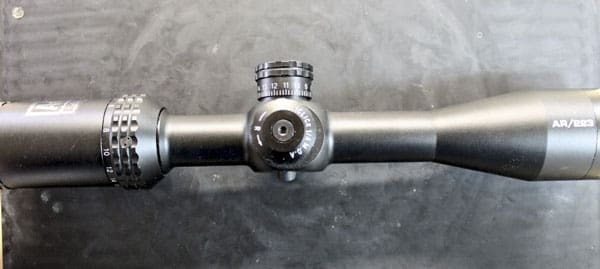
One of the most common questions I see on message boards and in the comments section of reviews is, “What optic should I put on this rifle?” Most of the modern sporting rifles today ship without sights of any type. Those that do, usually ship with irons only. I don’t begrudge irons, in fact I like them quite a bit. But hitting things “over there” gets a lot easier with some optical magnification.
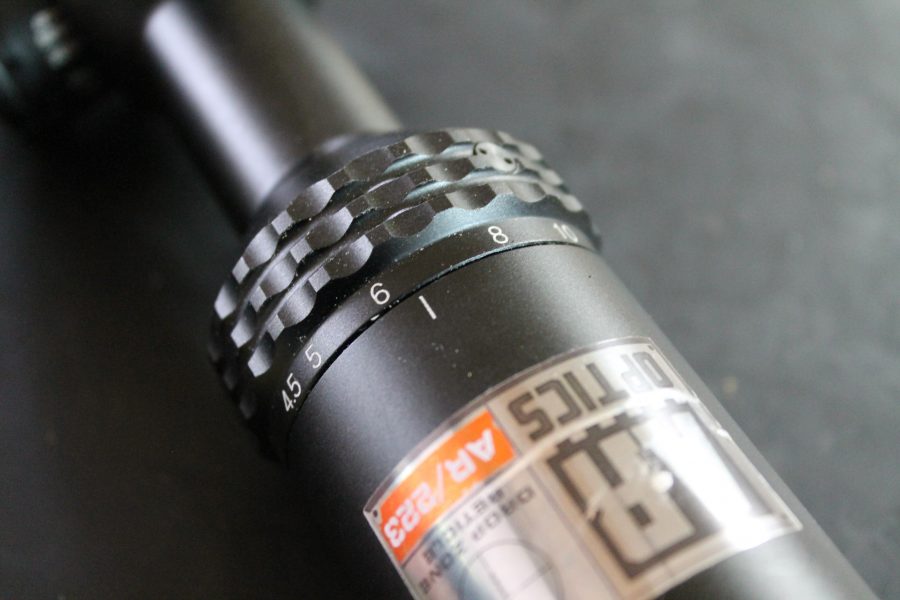
The problem then is that you already paid a lot for the rifle, the bits to put on it, a case, ammo, and of course lots for some training. An optic is, at that point, the place where many gun owners choose to save a few bucks. Sensing this, many manufacturers produce budget priced scopes to entice potential buyers. In and of itself, less expensive isn’t necessarily bad. But in a sea of low priced optics, manufacturers are forced to differentiate a bit and this is where it starts to have some potential to unravel.
One of the hallmarks of the “cheap” scope is a plethora of features. Many of these features mimic the capabilities of the higher priced optics from the same manufacturer. Consumers might look at that feature list and say, “Hey there. All the features of the expensive model at 1/5 the cost. What’s not to love?” I recently got my hands on a $209.49 Bushnell AR Optics 4.5-18x40mm that includes their handy dandy Drop Zone 223 Reticle to find out for myself.
I found this to be convenient since I’d written about Bushnell’s DMR line of scopes last year. The DMR was and continues to be my favorite scope for those looking for big boy features at a “reasonable” price. At a price point just north of $1000, it checks all the boxes for features while also actually working very well. It doesn’t hold a candle to a Schmidt, but it also doesn’t cost 3X more. Give and take.
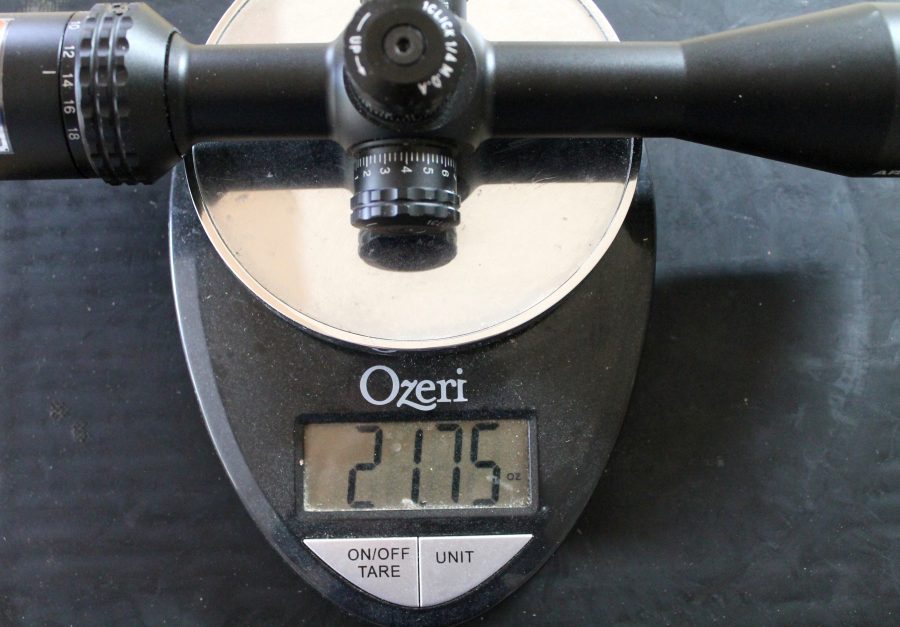
Unboxing the AR Optics scope, it was apparent that a great deal of the features that I loved from the DMR came over to the much less expensive model in my hands. Oh sure, at a hair under 22 oz, it was almost a full pound lighter which addressed one of my biggest complaints with the DMR line. That Jane Fonda weight loss program isn’t entirely unexpected given that the DMR uses a 34 mm diameter body while the AR Optics uses a one inch (25.4 mm) diameter tube.

There on the left hand side was a nicely textured parallax adjustment knob, just like the DMR had. Unlike the DMR, the AR Optics version went down to 15 yards and up to infinity. Certainly an improvement. Unfortunately, that was the extent of the improvement as the adjustment knob was very stiff.
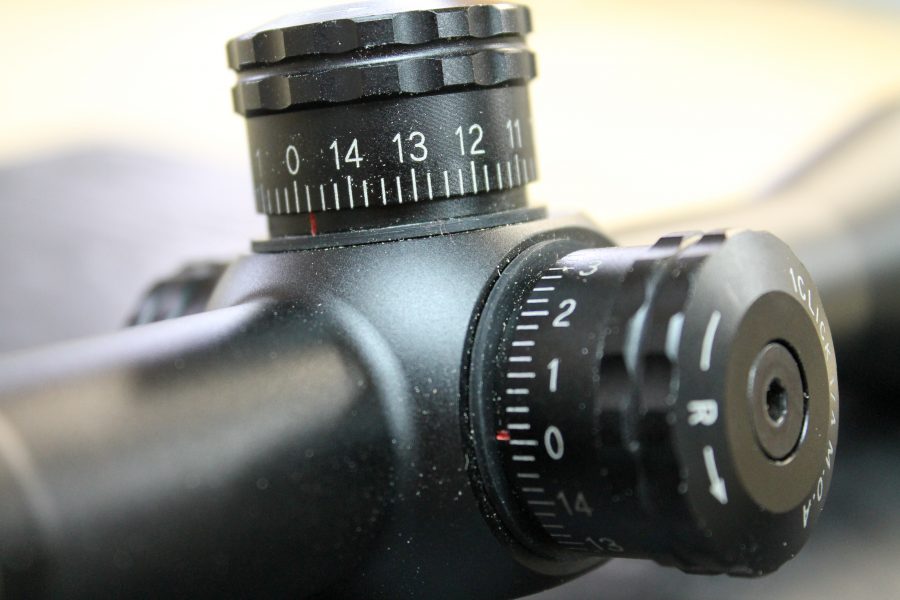
A cursory glance over the scope body also revealed the existence of adjustable turrets marked 1/4 MOA per click. At 15 MOA per revolution, that’s enough elevation travel to get my rather pedestrian 55 gr .223 REM loads out to ~500 yards. That’s about as far as I’d ever shoot that little pill, so it’s an adequate adjustment distance in my humble opinion.
The feel of the knobs however, is not exactly confidence inspiring. They’re mushy like like a well stewed tomato, and kinda, sorta, maybe land on the adjustment you were hoping for. Or maybe they don’t. After my testing was complete, I removed the O-rings that sit under the caps, and cleaned out all the grease. This made for a marked improvement in feel, but there’s still a lot of slop and play in the turret. I’d ballpark it at somewhere approaching 1/8 MOA in total slop. Not ideal for the sort of test I planned for it.
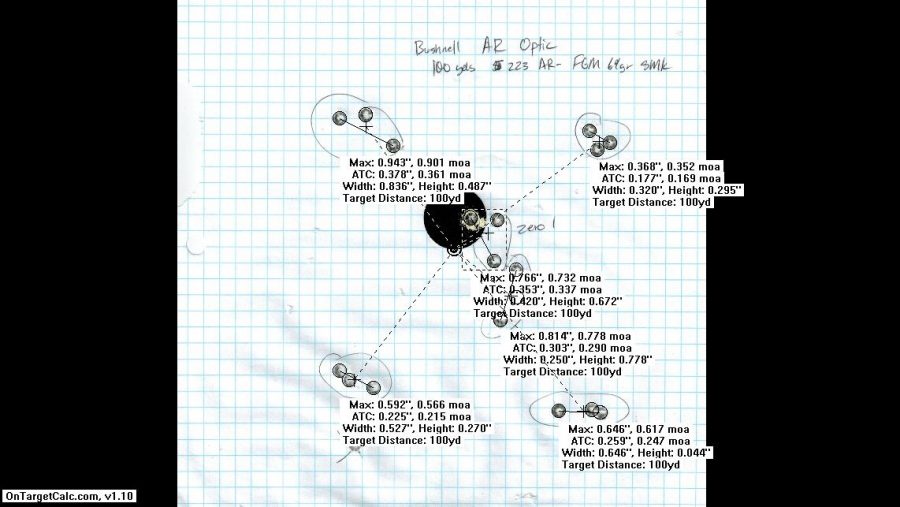
That test is a simple box test. I got a good zero using Federal Gold Medal 69 gr SMKs, and then moved the turret up and right 2 MOA, aimed at the same point and shot three. I moved the turret 4 MOA down, shot three, and continued this process moving my way around the box until I was back to zero. Keen eyed readers will notice that the return to zero has zero overlap with the original zero.
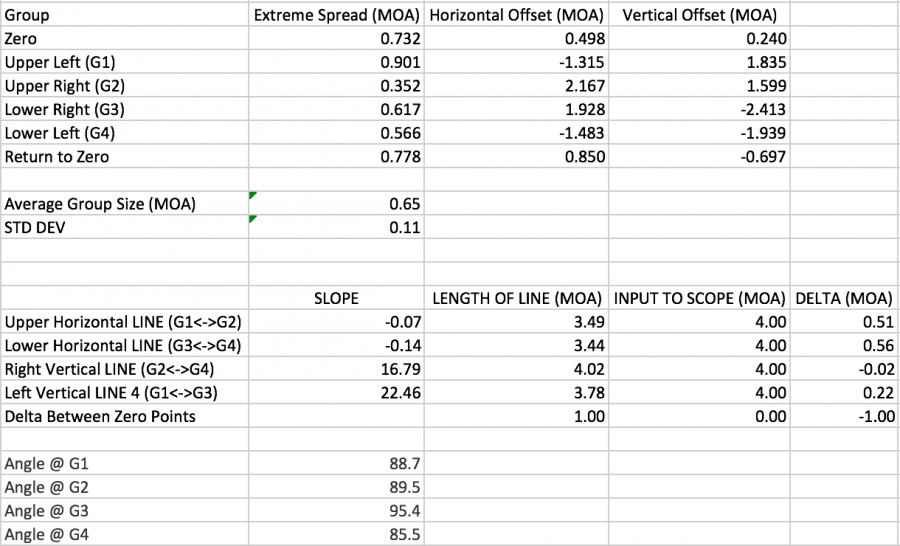
In the interest of science, I plugged all six groups into OnTarget. OnTarget was kind enough to tell me the extreme spread of my groups as well as their coordinates relative to my point of aim, the bottom of the black one inch shoot n see dot in the photo above.
Using a tricky bit of middle school math, I calculated the distance between each coordinate point measured in minutes of angle (MOA). In tandem, I measured the angle at each point formed by the imaginary lines.

As a rough measure of quality, three things should happen when Excel gets done chugging through these numbers. First, the angles at each group should be within a degree or two of ninety degrees. This would describe a roughly square “box” between all the coordinate points. The AR Optics fails this with G3 and G4, the lower left and right hand groups.
Second, the distance between coordinate points, described in my spreadsheet above as “LINE” should be roughly equivalent to the inputs I gave the scope. A bit of variation is expected since I’m using a firearm and not a precise optical collimator. The amount of acceptable variation in the length of the line is less than the standard variation of my group sizes, i.e. .11 MOA.
You’ll notice that only one line, the distance between the upper and lower right side coordinates is within that window of error. The rest are double to nearly five times the size of my standard deviation number. That’s not exactly the most worrisome thing as I’ve seen very expensive optics fall to the outer boundaries of the standard deviation number. As long as the difference between the expected value and the actual value is consistent and repeatable, you can work around it.
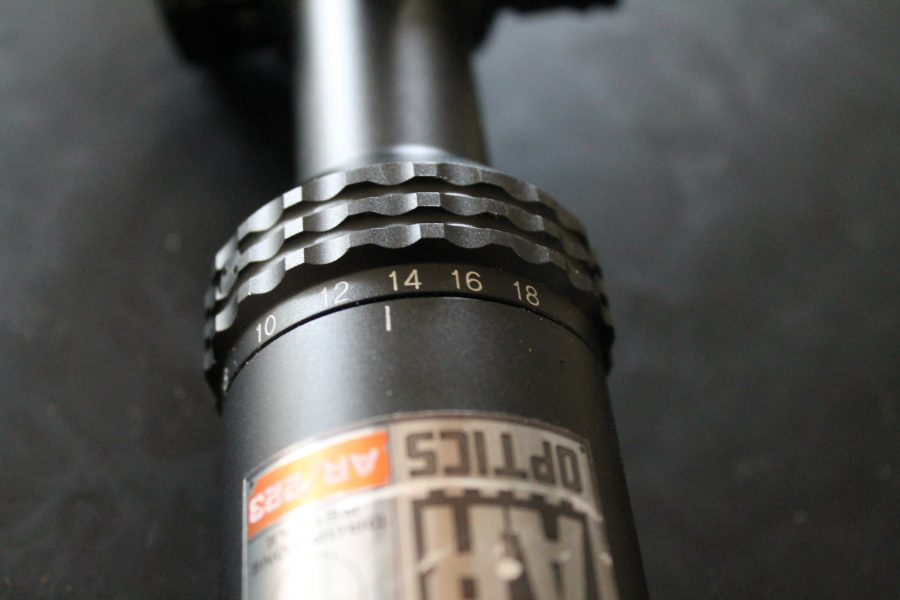
The third key indicator is return to zero and unfortunately, there’s approximately one minute of difference between the original zero and the return to zero. This is not ideal by any stretch of the imagination as return to zero is a cornerstone of reliability in an optical aiming device. If you were looking to purchase this scope, I’d recommend that you set it and keep the turrets locked. You’ll be responsible for some Kentucky windage beyond that, but hey, the AR Optics comes with a BDC reticle, perfect for that sort of thing.
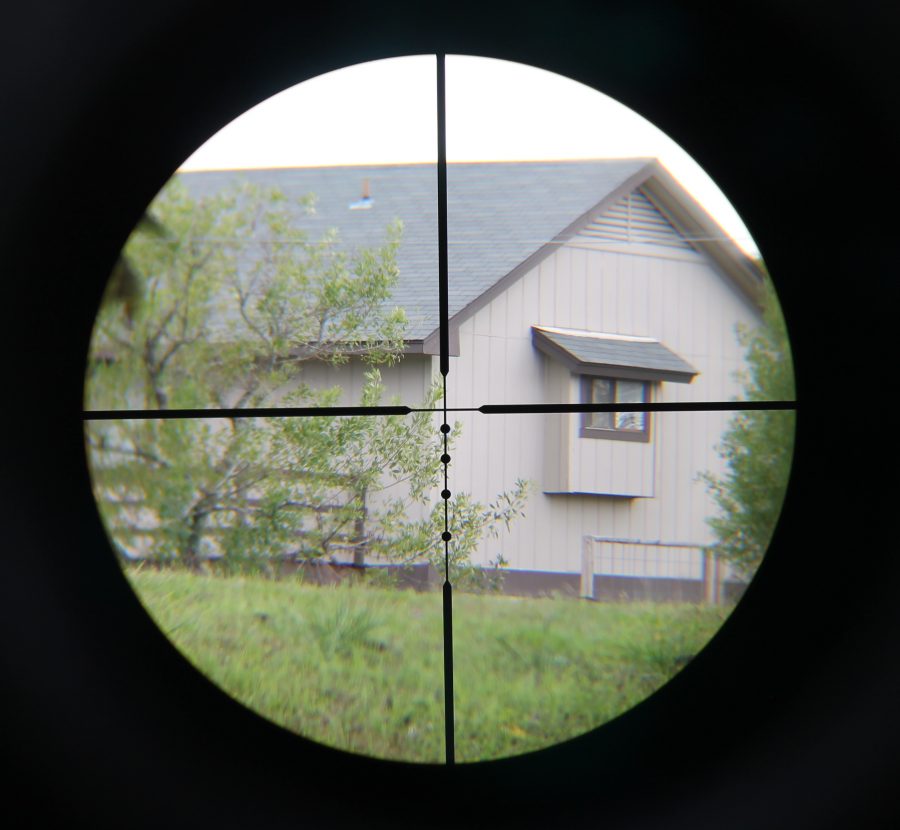
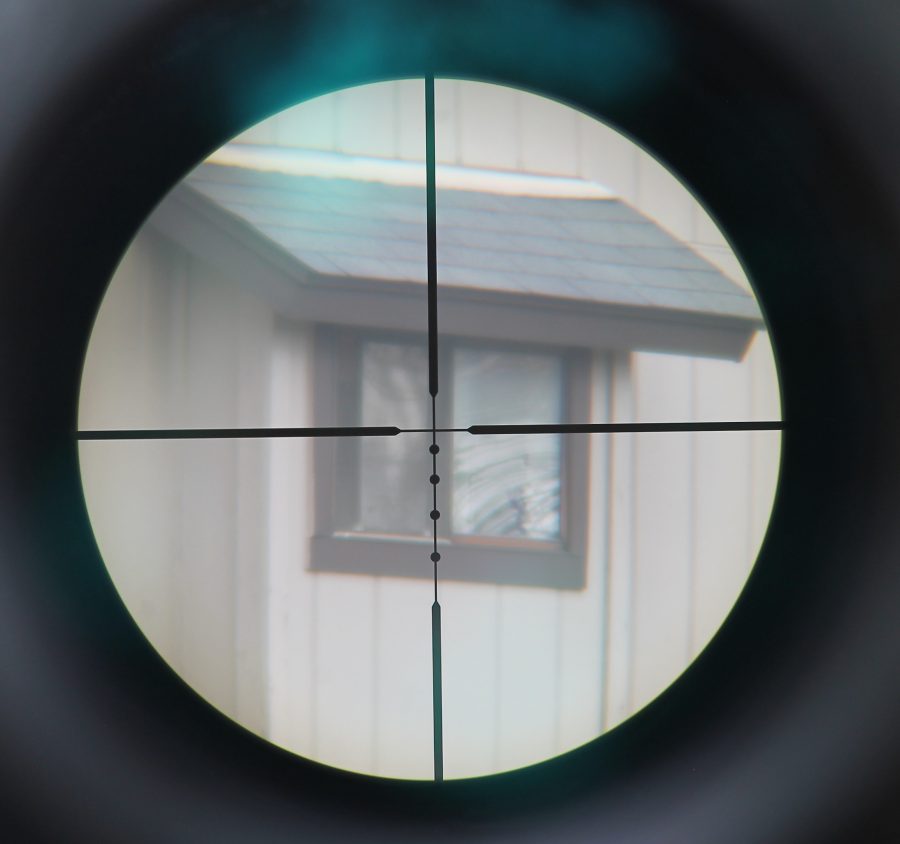
If you’ve read my reviews in the past, you’ll no doubt remember that I am not a big fan of the BDC reticle. The biggest reason is that there’s such a variety in projectile weight and velocity, that no reticle is going to line up perfectly, especially out to the sort of ranges where elevation holds start to really make a difference. The other big reason is that the BDC reticle has no consideration for wind. And given that wind holds vary just as much based on projectile weight and muzzle velocity, you can see how the BDC reticle might be the sort of thing that looks good on paper but falls apart in practice.
That said, there are two factors worth consideration on the BDC reticle. The first is if it’s attached to a first focal plane scope. If so, the holds are always the same no matter the magnification, and you can truly “learn” the reticle in such a way that you can use it in all conditions. I find that I have to back off max magnification a touch when it’s hot out and the mirage is bad. Also known as March through November in Texas. A first focal plane scope allows me to still use the reticle for measurement in that scenario where a second focal plane scope requires that the scope be at max magnification for the reticle subtensions to be accurate.
The second factor worth consideration on a BDC reticle is if the subtensions are clearly marked and identified. If the manual states that the aiming dot is at 3 MOA, but you know that at 250 yards, your correction is 2.8 MOA, you can hold a touch under and probably be on the money. You still need to know your holdovers and wind dope for your load, but I think you can still be effective.
As an example, at my elevation and weather at the time of this writing, my 55 gr load for my AR requires 2.8 MOA of elevation correction at 250 yards. My 77 gr load at the same distance requires 3.8 MOA. No single BDC reticle can cover both of those loads, but if I know that the “dot” in a BDC reticle is at 3 MOA, I can make the whole thing work.
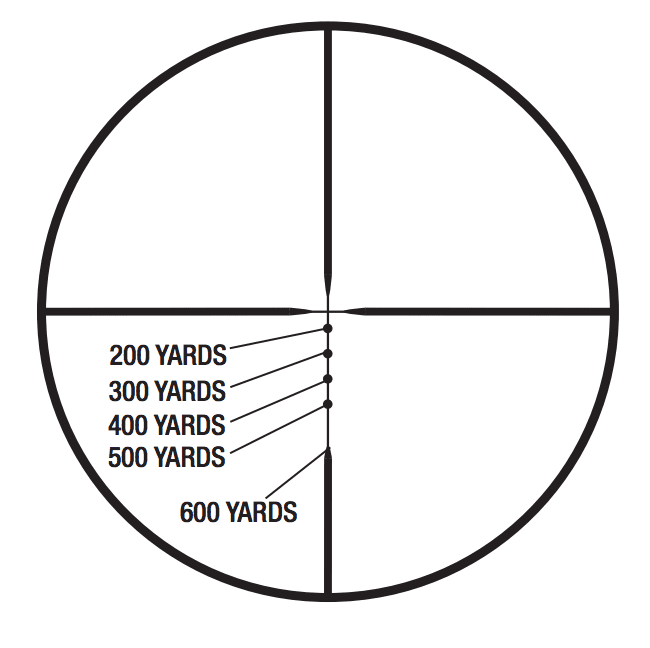
I mention this specifically because Bushnell does not ship any documentation with the AR Optics scope beyond what you see above. And you’ll have to forgive me, but I think a slow Texan such as myself might need a bit more info. In fact, I had to really get to googling before I found any reference to those subtensions. Over at SnipersHide, someone posted the results from their conversation with a support representative at Bushnell who indicated that the dots work out to be 1.7 MOA (200 yards), 4.4 MOA (300 yards), 7.6 MOA (400 yards), and 11.4 MOA (500 yards).

A cursory glance at my ballistics calculator at the time of this writing indicates that my 55 gr load would work out to be 210 yards, 300 yards, 385 yards, and 465 yards with those aiming points. It isn’t off my leaps and bounds, but I still wouldn’t trust it for anything other than plinking on large targets. Furthermore, there’s no discussion of dot size, though I’d guess it to be about 1 MOA in diameter. I think a competent shooter could learn this reticle, but their time and ammo might be better spent on other pursuits.
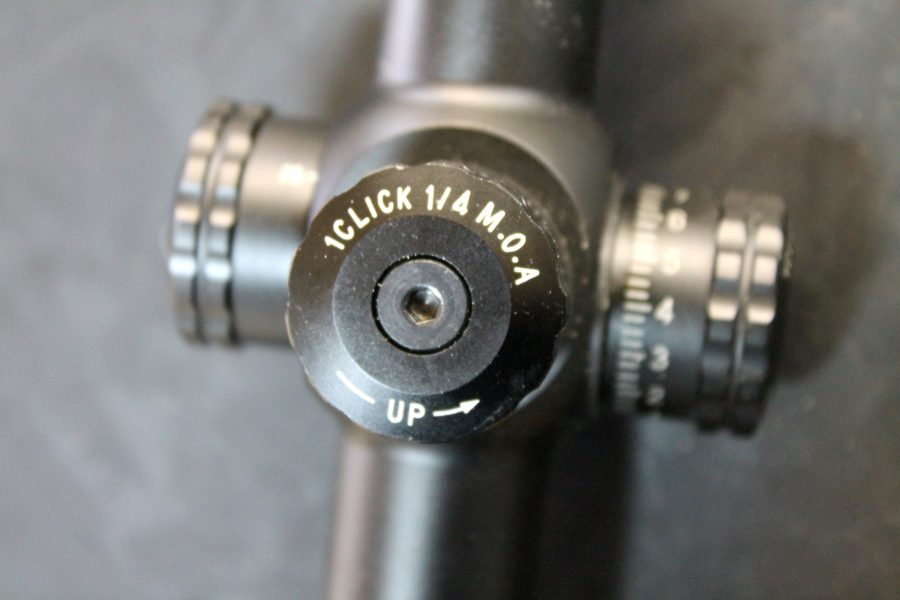
No optics review would be complete without a discussion of optical quality, and this is one area where I have to give a nod to Bushnell. It seems like not too long ago, you couldn’t simultaneously spend $200 and also see things with any sense of clarity or resolution at dawn or dusk. In this regard, I’d say that Bushnell has a winner on their hands.
Comparing it to a few other optics I had around in the same price range, and a bit pricier, I found the AR Optics to allow near dusk identification of targets out to several hundred yards. You’ll definitely need to back off the magnification though as even the highest end scopes have a difficult time at full power and low light. While it doesn’t even begin to compare to its higher end brethren in the Elite series, it does a fine job and is extra special fine when price is taken into consideration.
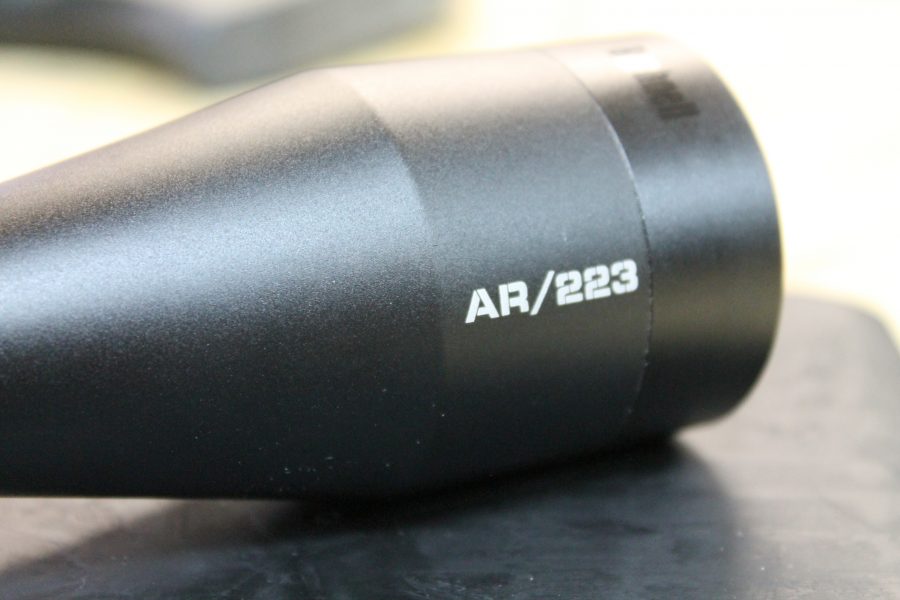
In the end, though, the AR Optics scope is jam packed with features that are, for the most part, poorly executed. There are turrets, but they don’t track well or return to zero. There’s a BDC reticle but Bushnell doesn’t give you subtensions and because this is a second focal plane scope, they only work at the highest power setting which is 18X. That’s too much magnification to be practical for the average shooter and it certainly is too much magnification for the optical quality on display.
Specifications: Bushnell AR Optics 4.5-18x40mm Riflescope w/ Drop Zone 223 Reticle
Finish: Matte
Power x Obj. Lens: 4.5-18x 40mm
Reticle: Drop Zone-223 BDC (308 available)
Lens Coating: Fully Multi-Coated
Tube Diameter: 1 inch
Weight: 21.5 oz (21.75 oz measured)
Length: 12.4 inches
Eye Relief: 3.7 inches
Focal Plane: Second
MSRP: $323.45
Street Price: $209.49
This scope was provided for review by OpticsPlanet who happily offers 5% off your entire order anytime when you use the code TTAG5 at checkout. Through December 25, 2016 use TTAG10 for 10% off your entire order.
Ratings (out of five stars):
Fit, Finish, Build Quality * * *
While the AR Optics looks good, the turrets feel like they’ve been soaking in jelly and the rings that change magnification and parallax are very stiff. You can mitigate some of the stiction in the turrets by removing the O-rings that seal out dust and moisture, but then you can get dust and moisture inside your scope turrets, so weigh that carefully.
Optical Quality * * * *
This isn’t the best glass I’ve ever looked through, but that isn’t apparent until you crank the magnification ring up to 18X. At the lower powers, image quality is crisp right down until the last bit of legal light has disappeared. Up at the high magnification settings, there’s some blurring and distortion that would be unacceptable in a higher quality optic, but is certainly expected at this price level.
Turret Tracking * *
I’ll give it two stars for going in the direction I wanted with some semblance of accuracy, but I’d never trust these turrets in a competition or hunting situation. Your best best is to use them to set the zero for your scope and then lock them in place with some super glue so you don’t bump them loose.
Reticle * * *
I’m no fan of BDC reticles and this is really no different. I’d say that the ideal holdover reticle is probably something like the Horus H59, something I doubt I’d ever see at this price point. In an ideal world, this reticle would use flat lines with enough horizontal length to equate to some sort of wind hold. A stripped down version of the Vortex EBR-2C or other “Christmas tree” reticle would be the ideal goal, but honestly anything would be better than these fat dots with some sort of vague elevation graduation.
Overall Rating * *
If $200 is your budget, the world is your oyster for cheap optics, but this would be further down my list of possibles. I’d feel much better if Bushnell had capped the turrets and spent a bit more time on making a more functional BDC reticle. If you’re looking at buying this scope, set the zero, superglue the turrets, and spend the money you saved on enough ammo to help you learn the finer points of holding off for elevation and wind.

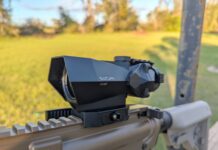


Seems like for just a bit more you can get a primary arms 4-14x with FFP and a really snazzy ACSS reticle, or for almost the same price get a primary arms mil dot FFP 4-14x. Either one of those would beat this scope.
I went with the Primary Arms option and count not be happier.
At that price point, I think the only thing that could have done worse would have been a Barska. Ugh.
Great, thorough review.
Now here’s my unsolicited advice. If you are going to skimp somewhere, skimp on the rifle over the optic. It’s perfectly reasonable, and smart, to buy the best glass you can afford, and then work your rifle(s) up to the best you can afford over time. Learn that scope like it was your eyes.
^^^This! Don’t skimp on the glass. You can make a cheap rifle better with good glass but you can’t make cheap glass better with a high end rifle.
How did you mount the scope? Looks like it might not have been perfectly level.
Maybe the building was leaning, but more likely, the gun was canted just a bit when the photos were taken.
Which leads me to the “box” test. If you don’t have an honest-to-God target designed for that purpose, with big, thick vertical and horizontal lines on it to make sure your gun isn’t leaning one way or the other, then such testing will yield dubious data at best. I don’t think that graph paper is gonna cut it. However, the return to zero should, um, return to zero, regardless.
You seeing something I’m not? The pics I’m getting do not show the orientation of the rifle. How would you get the concept that the scope was not properly leveled?
Thanks for the great review, lots of good info I had not considered.
Best bang for your buck scopes = SWFA
Perhaps someone can explain to me the utility of a 40x scope? Especially on a 5.56 rifle? What good does it do to allow you to see what you might hit, if you’re lucky? Tell me how many rounds it will take for you to hit that prairie dog at 1,000 yards?
it’s not a 40x, it’s 18. 40mm is the objective lens measurement. know what you’re talking about before you start bitching…
I apologize for my momentary lapse in reading comprehension. I do know the difference. And I still think an 18x scope is beyond the realm of usefulness for a 5.56, and a 24x is beyond useful for anything else in the small arms category, save perhaps the long range bullseye competitor.
But I’m open to lucid arguments to the contrary.
Curtis, a few posts up someone mentioned the concept of buying just any old rifle and putting extreme glass on it, early in your game, then upgrading the rifle under the same glass. Really makes sense to me, wish I’d heard it 50 years ago. After 5 years and 10,000 rounds, put a .308 under it, another 5 years, a .338 Lapua. Is it making more sense, yet?
I just got stupid enough to spend $2500 on a Leupold 1-6x, to put on a .308. I’m looking to discover how much difference I can detect, but at my age (70) I don’t expect to finish any research I begin. But (pay attention, now) it’s still fun. Isn’t that what we seek? (I couldn’t afford it when I was 30!)
Regarding BDC reticles: It’s disappointing Bushnell doesn’t offer more resources to make them at least somewhat useful.
Other manufacturers (e.g. Nikon) have online ballistics calculators that allow you to plug in your data and print dope cards that give you the distance for each mark on the reticle. You can even print multiple cards for different magnifications if you want.
There’s an app called strelok which will let you put in your ballistics and get accurate BDC holds for just about any scope on the market.
I have the Pro version of this app and this scope is listed as well as almost every scope on the market. The app takes the all the guesswork out of the retical. You can even find out at what range the dots equal at diferent powers.
The kicker there is though that unless Nikon has changed, if you want it on your phone, you’ll need to fork over $5.
$5 = 10 rounds of 69 grn HPBT. Is that really a problem?
A couple of issues that need to be covered in any optical review:
1. Is it fog proof & water proof? Did you test these claims? Fastest way to do it is to fill a sink with warm water, and dunk it in. Look for bubbles. If you see bubbles, it failed.
Now pull it out of the warm water, and see if it fogs on the inside. If it does, fail.
2. There’s obvious distortion at the outer field of view of this scope in the 18X @ 100 yards picture. Look at the lower right quadrant, towards the outside edge of the view. You can see the barrel distortion when you look at the vertical lines of the building’s siding. Optics reviews should, as this one did, include pictures taken through the optic at a building or other source of nice, straight lines. This is how you spot pincushion and barrel distortion.
Lots of glass has spherical distortion at the outer edges, especially at higher magnifications. I once returned a pair of Steiner binocs that had pincushion distortion (pretty bad distortion, too) at the outside edge of the view. They were 8×56, as I recall.
3. Chromatic distortions and artifacts inside the optics are something else to check for. Point the scope into the sun, then come off the sun. As you move off the sun, you’ll see artifacts and (in cheaper optics) chromatic problems.
4. Mechanical durability. Put it on a hard-recoiling rifle (eg, a .338 WinMag or heavier), and shoot to see if it holds the zero. Lots of cheaper scopes can’t – and when you try to run the box test (kudos for running the box test, with math, BTW – that’s very good) on a scope that’s been mauled with some recoil, you find out just where your money goes in a high-dollar scope.
Want to see how to really maul some of the mid/high dollar scopes? Put it on a piston air rifle. A .177 would be fine. It used to be that you could see the guts shake out of even better quality scopes when you put them on an air rifle.
Good optics cost money, for a reason. Good optics also have real mass to them – again, for a reason. There’s no getting around physics.
In my younger days, I ruined a scope of my dads by mounting it on my pellet rifle.
“Point the scope into the sun, then come off the sun. As you move off the sun, you’ll see artifacts and (in cheaper optics) chromatic problems.”
How do you do that without destroying your retina?
Look buddy, do you want to know if your scope is good or not? Damn kids can’t even handle a burnt retina.
You do it quickly. You’re looking to gain alignment with the light source (you could use a halogen headlight at night, too), but you don’t need to be looking at the light source for more than a fraction of a second, if that. You just need to get the light source close to co-axial with the scope’s light transmission path, then work your way off that axis. You’ll see the artifacts show up quickly enough on a cheap scope.
DG, I love ya, but you need to clarify greatly, you are advocating people blinding themselves! You do *NOT* point telescopes at the sun, while looking through them! Period! Unless you have 5 or 6 people you don’t know pointing loaded guns at you, at the same time. Understand? It’s a no-no, for a good reason.
Other than “it looks cool” I still don’t get why scope makers put turrets and unusable magnification ranges on cheap scopes. This goes up there with aerodynamic body kits and spoilers for cheap cars. Come to think of it, there probably plenty of overlap in those two markets.
IMO Vortex makes the best BDC in this segment, simple lines with explicitly spelled out elevation subtebsions in the owners manual, a nifty calculator that you can use to match it to your exact loaf, and it has two holdoff lines for wind. The magnification ring on their SFP scopes has the magnification level and a multiplier so you know exactly how much to adjust your holds by as you back off the elevation.
I’m with you on the magnification here, but turrets are useful for quickly adjusting for different loads. Bullets of different weights will need different scope adjustments at 100 yards.
Except for when they don’t track properly or return to their previous setting reliably (see the box test above).
Bushnell appears to have put reasonable glass in this, if it had capped adjustments, and a lower top magnification it could probably be $50-75 cheaper, or maybe they could have put a reticle in it that doesn’t suck. People wouldn’t buy that though.
Turrets on my scope are really handy for correcting suppressed vs not suppressed.
I didn’t say turrets were bad, I agreed with the review that shitty turrets, that don’t track properly or hold zero on cheap scopes are bad.
If your suppressor consistently changes POI by 2 MOA and your scope turrets sometimes dial in 1.75, sometimes 2.25 is it really helping?
I don’t agree, look at that
http://gerdasteinerdesigns.blogspot.de/2015/07/using-felt-to-add-texture-to-sheep-from.html
I bought a Bushnell 4.5-18×40 AR from a friend. The parallax knob, however is so stiff that I can hardly turn it. How can I solve this problem?
Comments are closed.